This post may contain affiliate links. Please read our disclosure policy.
Singapore fried carrot cake is a savory dish made of steamed radish/turnip cake cut into cubes and stir-fried with eggs and seasonings. A popular hawker fare that you can make at home. A recipe for homemade chai tow kway is included too. You can make a white or black version of fried carrot cake.

Singapore Fried Carrot Cake (Chai Tow Kway): A Beloved Hawker Delight
Despite its name, Singapore Fried Carrot Cake has nothing to do with the sweet, spiced cake popular in Western bakeries. Instead, this beloved hawker dish features stir-fried cubes of daikon radish cake, known as “Chai Tow Kway” in Hokkien. The dish is a staple in Singapore and Malaysia, commonly found in hawker centers where locals enjoy it for breakfast, lunch, or a late-night snack.
History and Origins
Chai Tow Kway traces its roots back to Teochew immigrants from southern China, who brought the tradition of steaming daikon radish cake. Over time, Singapore’s hawkers adapted the dish by pan-frying and stir-frying it with eggs and preserved radish. This evolution led to the creation of the white and black versions enjoyed today.
What is Singapore Fried Carrot Cake?
Singapore Fried Carrot Cake consists of soft, pan-fried radish cake (turnip cake) that is stir-fried with eggs, preserved radish (chai poh), and garlic. The dish is prepared in two styles:
1. White Carrot Cake (Bai Chai Tow Kway) – Stir-fried simply with eggs and seasonings, resulting in crispy golden-brown bites with a soft interior.
2. Black Carrot Cake (Hei Chai Tow Kway) – The same dish, but with the addition of sweet dark soy sauce, giving it a deep, caramelized flavor.
Both versions share the same base but have distinct flavors and textures, making it a matter of personal preference among diners
Singapore Fried Carrot Cake / Fried Turnip Cake (with Homemade Chai Tow Kway)
Ingredients
If using homemade Chai Tow Kway (7x7x2 inch) yield about 600-700 grams cooked:
- 250 gr daikon weight is after peeling off the skin.
- 480 gr water to cook the daikon
- 150 gr rice flour
- 15 gr cornstarch
- 15 gr tapioca starch
- ¾ tsp salt
- 220 gr water
If using ready-made daikon/turnip cake:
- 600 gr Daikon cake about 1 1/2 lbs, cut into cubes
For stir-frying:
- 3 Tbsp lard or use cooking oil for healthier version
- 4 cloves garlic (peeled and finely minced)
- ½ cup sweet chai poh soaked in warm water and then cut into smaller pieces
- 4 eggs lightly beaten
- 4 handful fresh bean sprouts
Seasonings:
- 1 tsp fish sauce or more to taste
- 1 tsp soy sauce or more to taste
- 2 Tbsp dark soy sauce omit for white version
Instructions
Make the chai tow kway (prepare the day before):
- Line the base of the pan you are going to steam the cake in with a parchment paper. It's easier to take it out later.
Precook the daikon:
- Traditionally made with the Chinese daikon/radish (white long tuber), but if you live outside of Asia and if it's hard to find, I have also tried the small red radishes, which is more abundant here in the U.S. Just peel off the red skin and they have very similar taste to the Chinese daikon/radish (not to mention they are cheaper too)
- Use a fine grater to grate the daikon into shreds
- Put your pot on a kitchen scale, add 480 grams of water, 250 grams of shredded daikon and take note of the total weight including the pot. Write it down somewhere or take a photo of the weight with your phone.
- Put this on the stove and bring the mixture to a boil and then cover and lower the heat to simmer for 5 minutes. The daikon should be soft. Turn off the heat

- Put a trivet on the kitchen scale again (you don't want to burn the scale). Zero it out so it won't take the weight of the trivet. Put your pot on the scale to weigh again. The total weight should be about 100 grams less than before after cooking.
- For example if you started with 1730 grams total weight (your pot + 480 g water + 250 g shredded daikon), after boiling, the total weight should be around 1630 grams. If it's not less than 100 grams, discard some of the liquid to make up for it. If it went down way more than 100 grams, you can add some water to make up for it.
Cook the batter:
- Combine rice flour, cornstarch, and tapioca starch with 220 gr of water in a large wok or skillet. Stir or whisk until you get a smooth batter. Don't turn on the heat yet.

- Bring water in the steamer to a boil while waiting. Add the cooked daikon and the cooking liquid into the flour mixture and stir to combine.

- Turn on the heat on low-medium and keep stirring until the batter starts to get creamy and thick but not too thick that you can't stir anymore. Remove from the heat

- Transfer the thickened batter this into a round or square pan lined with a parchment paper at the bottom (it's easier to unmould later) and use a spatula to smooth the surface. Steam over high heat for 50 minutes to 1 hour.

- NEW UPDATE: A skewer inserted into the center of the cake may not come out clean. So it's not a very accurate test. Open the lid of the steamer and let the cake sit in there for 5 minutes. The surface will dry up a bit. Lightly press the cake and it should bounce back lightly and doesn't feel mushy or wet. The cake will firm up considerably once it cools down
- Let it cool down completely for 1 hour at room temperature and then let it cool down further in the fridge for at least 6 hours or longer. The texture needs to be firm enough before you can cut and use it for stir-frying.

Fried carrot cake:
- Mix the seasoning ingredients and set aside. Cut the carrot cake into about 1-inch cubes. Preheat a large wok/skillet on high heat. Add 1 Tbsp of lard/cooking oil. Add the carrot cake in one single layer and fry until crispy and a thin crispy crust forms

- Then flip to the other side until lightly golden and slightly crusty.

- Add another 1 Tbsp of lard/oil and add the garlic and chai poh and stir-fry briefly for until fragrant, about 1 minute

- Pour the beaten eggs over the carrot cakes and leave it for a while. Do not stir for about 10 seconds.

- When you see the eggs start to solidify at the bottom, flip it over and cook the other sides and drizzle with last tablespoon of lard/oil. Add seasonings and stir to mix everything.

- Add the sprouts and stir fry for another 10-15 seconds or until the sprouts are heated through but still crunchy and not wilted

- Turn off the heat. Dish the fried carrot cake up into serving platters and serve immediately

RECOMMEDED TOOLS
Marv’s Recipe Notes
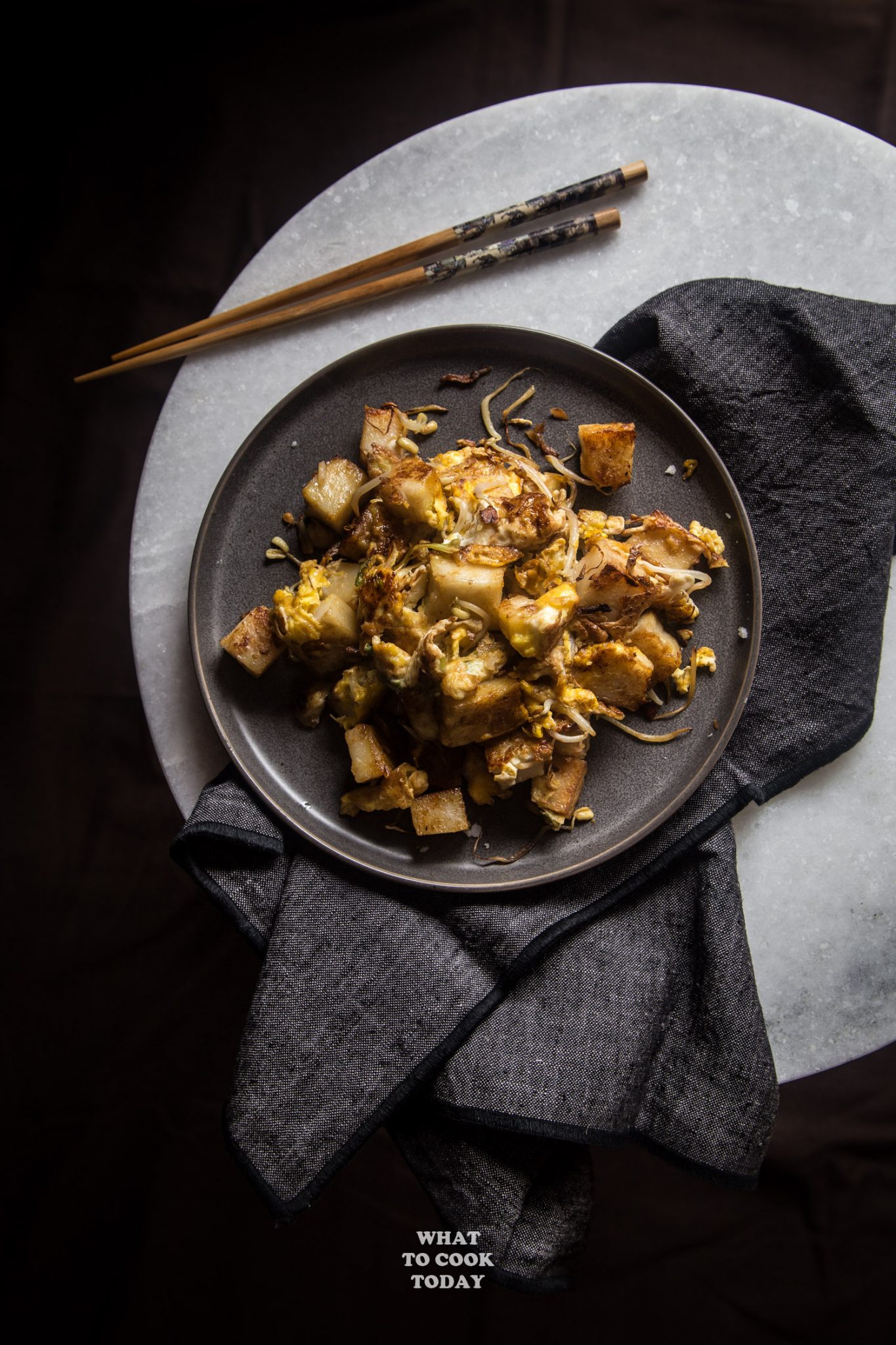
Regional Variations
While Singapore’s Chai Tow Kway is the most well-known, variations exist across Southeast Asia and China:
1. Cantonese-style Turnip Cake (Lo Bak Go) – Typically served in dim sum restaurants, this version is steamed with Chinese sausage and mushrooms and pan-fried rather than stir-fried.
2. Malaysian-style Chai Tow Kway – Similar to Singapore’s version but sometimes includes sambal for an extra spicy kick.
Customization & Variations
While the classic versions are popular, some variations include:
1. Using Duck Eggs – Provides a richer, creamier texture compared to chicken eggs.
2. Toppings like Chinese Sausage or Shrimp – For added umami and depth of flavor.
3. Extra Chai Poh (Preserved Radish) – Enhances the dish’s signature savory-sweet taste.
How to Enjoy It Like a Local
Singapore Fried Carrot Cake is best enjoyed hot, straight from the wok. Locals often pair it with:
Kopi (Singapore-style coffee) or Teh (milk tea) – The strong, bold flavors complement the dish well.
Sambal Chili – Adds heat and depth to balance the sweetness of the black version or enhance the savoriness of the white version.
Whether you prefer the simplicity of the white version or the rich, caramelized flavors of the black version, this dish is a must-try for anyone exploring Singapore’s street food scene. Have you tried both styles? Which one is your favorite?

You might like this homemade Lo Bak Go (Dim Sum Turnip Cake) too

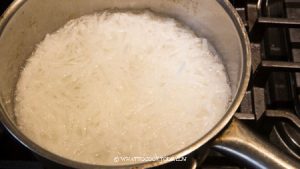
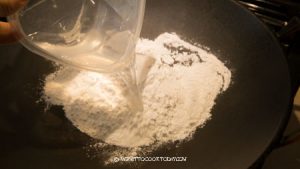
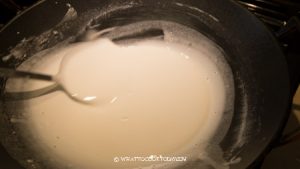
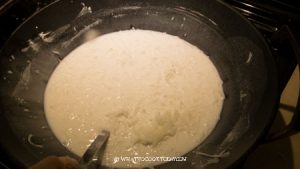
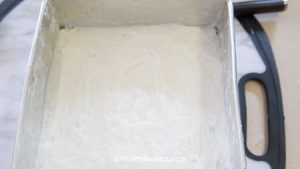
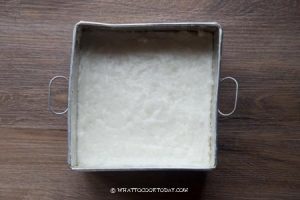
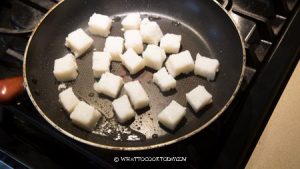
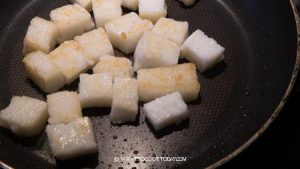
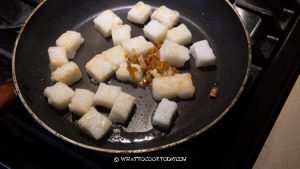
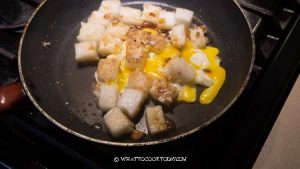
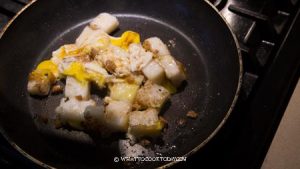
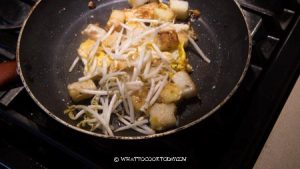
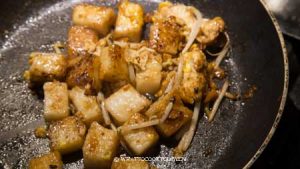

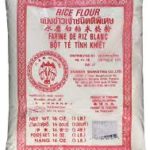

22 comments
Hi Marv, I just made your carrot cake and I have to say you have taken me back to Singapore! I miss all my home foods so thank you for taking the time to write all your recipes. I really do appreciate it. I am going to enjoy a second round of carrot cake now!
Hi Monica, I’m glad you like it 🙂 It is one of my favorites as well.
Hi I’m from Singapore. I use store bought radish cake and not sure why. only first 2 mins of the cooking (oil and carrot cake) I can feel the cake getting softer and as i cook it becomes even more mushy. Pls help.
Hi CQ, I wish I could comment more but I don’t know much about the store-bought radish cake you used. I wonder if it has been frozen before and that changes the texture making it more crumbly
Hello, how much water from the cooked daikon should I use? All of it (after simmering the daikon) came to more than 1 cup. I added all of it and the result is very watery even after steaming for more than 1 hour. Sigh. Would appreciate if your instructions are clearer. Thanks
I apologize for the confusion. I retested the recipe again today and actually using 480 gr (or close to 500 ml) of water from boiling daikon yields a better cake (not as tough). Please make sure that when you cook the batter on the stove, it actually thickens before you pour it to steam. I’ve updated the recipe accordingly. Sorry for the trouble!
This recipe did not work for me to. I had to dry the steamed carrot cake in the oven at 100 degrees for 1.5 hours to get the clean chopstick. Maybe I should not have the lid while steaming the cake? Because the condensation added extra water to the cake.
Hi Shiyan, make sure you steam over high heat and you should have the lid on during steaming because we need to capture all the heat to cook the cake. It sounds like it just need longer steaming time. It appears soft and slightly wet on top when it’s just done steaming and once it cools down completely, it will firm up considerably.
Hi Marcelina, I just wanted to ask which supermarket in which part of Singapore can you get pre made carrot cake from? I’ve been searching for a while but just can’t seem to find it. Including the name of the product would be helpful as well. Thank you
Hi Nicole, I asked my sister who lives in Spore and she said that supermarkets like NTUC or Fairprice do sell premade carrot cake. Usually, it’s in the refrigerated section. I actually saw it before too when I lived in Spore for a short while. I can’t remember the brand name though.
This looks delicious!! your food and photography are beautiful!!
Awww…Thank you so much Kaylen!!